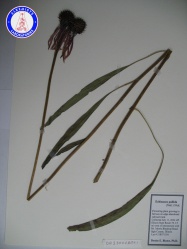|
|
| Line 1: |
Line 1: |
| − | =Introduction=
| + | {{DISPLAYTITLE:''Echinacea pallida'' (root)}} |
| − | ''Introduction from Wikipedia, the free encyclopedia (http://en.wikipedia.org/wiki/Echinacea_pallida, retrieved 02/27/2012).'' | + | =Nomenclature= |
| | | | |
| − | ''Echinacea pallida'' (Nutt.), commonly called Pale Purple Cone-flower, is a species of herbaceous perennial plant in the family Asteraceae. Its native range is the south central region of the United States.
| + | =Botanical Voucher Specimen= |
| | | | |
| − | ''E. pallida'' is similar to ''E. angustifolia'', but plants often grow taller, ranging from 1.5 to 2.5 ft (45 to 75 cm) tall, with some growing 3 feet (90 cm) or more tall. Plants normally grow with one unbranched stem in the wild, but often produce multi-stemmed clumps in gardens. They have deep taproots that are spindle shaped, wider in the center and narrowing at the ends. Stems are green in color or mottled with purple and green. The leaves are elongated lanceolate or linear-lanceolate in shape with three veins. Flower head rays are narrow, linear, elongated, and drooping, ranging from 1 to 3 inches (2.5 to 7.6 cm) long. The flower heads are from ¾ to 3 inches (2 to 7.6 cm) wide with pale rose-purple or nearly white colored petals. The flowers have white pollen. The fruits are cypselae and are tan or bi-colored with angled edges.
| + | {| border=1 |
| | + | | {{botcon |companyimage= AP-LOGO-Laboratories Crop - Copy.jpg |
| | + | | companyURL= http://www.alkemist.com}} |
| | + | |- |
| | + | | {{botimg |mainimage= Echinacea pallida OA23004BMX1 A0103.jpg |
| | + | |source= Botanical Voucher Specimen Library, Alkemists Laboratories http://www.alkemist.com}} |
| | + | |} |
| | | | |
| − | It is native to the United States where it is found growing in dry soils, in rocky prairies, open wooded hillsides, and glades. It grows natively as far north as Michigan and southward in to Alabama and Texas, and has been introduced outside of its native range into Connecticut, Georgia, Maine, Massachusetts, Minnesota, New York, North Carolina, and Virginia. E. pallida blooms from May into July. The states of Tennessee and Wisconsin list the species as threatened, mostly due to habitat loss and over-collection of roots.
| + | =Organoleptic Characteristics= |
| | | | |
| − | ''The quoted text in this section was licensed for use under the Creative Commons ShareAlike License, version 3.0: http://creativecommons.org/licenses/by-sa/3.0/''
| + | =Macroscopic Descriptions= |
| − | =Macroscopic Entries= | + | |
| − | {{Macroscopy | source=Botanical Voucher Specimen Library, Alkemists Laboratories
| + | |
| − | | mainimage=Echinacea pallida OA23004BMX1 A0103.jpg
| + | |
| − | | companyimage=AP-LOGO-Laboratories Crop - Copy.jpg
| + | |
| − | | companyURL=http://www.alkemist.com
| + | |
| − | | caption1=''Echinacea pallida'' Botanical Voucher Specimen - Alkemists Laboratories
| + | |
| − | | description=''Echinacea pallida'' Botanical Voucher Specimen }}
| + | |
| | | | |
| − | =Microscopic Entries= | + | =Microscopic Characteristics= |
| − | {{Request | source=Information Request
| + | |
| − | | description=''Echinacea pallida'' (root)
| + | =High Performance Thin Layer Chromatographic Identification= |
| − | }}
| + | |
| − | =HPTLC Entries= | + | =Supplementary Information= |
| − | =Other Points of Interest= | + | |
| | + | =Sources= |
| | + | |
| | + | <references /> |

